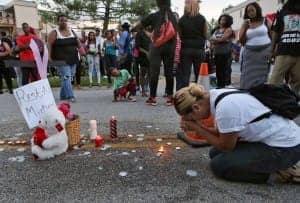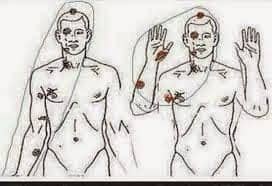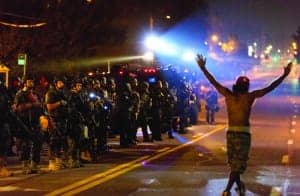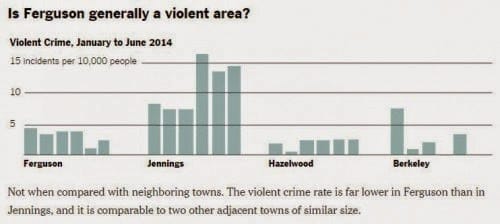Editor’s note: This is the revised version of the story originally posted here on Nov. 14, now fortified with more facts and sources.
by Cheris Place
My home is only about an hour from Ferguson, and I lived about 10-15 minutes from there for some time, so needless to say I’ve taken an interest in the events erupting there.
I was born and raised in Missouri, so hopefully I can shed some light on how Ferguson, a little Missouri suburb of 21,000 people, became the focus of the nation, and even the world. I am getting the stench that they’re about to pull the pin on another grenade to throw that community into upheaval, so first let’s take a hard look at what they’ve been through and why.
First of all, when we think of racism, we tend to think of Mississippi and Alabama due to the events of the ‘60s. However, Missouri was one of the bloodiest states during the Civil War. The state was torn in two, families divided by the issue, killing each other over what, in essence, was the right to be a racist. Because it was so divided, it is still that divided today, and that’s where we found ourselves last August in Ferguson.

To understand Ferguson, you have to be aware of its location to St. Louis. It’s really a suburb of St. Louis which, as late as the 1990s, was predominantly white. Many of the St. Louis suburbs are still predominantly white. Ferguson, however, for location and economic reasons, started to change, and to many of the white citizens of the St. Louis suburbs this was the beginning of degentrification.
From 2000 to 2010 alone, Ferguson went from being 52 percent Black to being 67 percent Black. Black people were doing better; civil rights laws and changing attitudes made it easier for people of color to move out of the “ghettos” they had been largely confined to.
Now those changes should be a good thing, but a lot of those white people in the suburbs had moved out of the city to get away from “those” people, so they resent them joining them in the “better neighborhoods.” Because they’re racist to begin with, they believe it lowers their property values when in reality it’s only their own bigotry that lowers their property values.
So what we ended up with in Ferguson was a 67 percent Black population still under an almost totally white government packed with racist people. That was always a time bomb waiting to blow because it is a situation that’s going to lead to abuses – and people will get enough of those abuses eventually.
So what we ended up with in Ferguson was a 67 percent Black population still under an almost totally white government packed with racist people. That is a time bomb waiting to blow.
As another nasty little piece to that puzzle, NPR reported that in 2013 the city issued just under 33,000 arrest warrants, more than one for every person in Ferguson, and collected over $2.6 million in fines and court costs, making it their second largest source of revenue. I think we can reasonably assume it was the 67 percent Black population that was the main focus of these revenues, which has also been adding fuel to the fire.
New York Times, 2014
In one year, 2013, voting among the Black population in municipal elections dropped from 54 percent to 6 percent. Really. It went down 48 percent! Why? My guess is that we couldn’t see such a serious drop in participation in only one demographic over one year unless that demographic was discouraged from voting. It should be noted out of six city council members in the city of Ferguson only one was Black, and the police department was almost totally white: 50-3.
Now that we’ve reviewed the background that set the stage for this perfect storm, let’s look at the events that unfolded, blowing the top off the pressure cooker, and how it’s been perpetuated and cultivated to keep this town broken.
On Saturday, Aug. 9, 2014, Michael Brown, 18 years old and unarmed, was shot down by Darren Wilson, a police officer, at just after lunchtime. He wasn’t shot once, but multiple times.
Immediately after the shooting, people poured out in the streets in shock and sympathy for the family. It started out as a peaceful protest and a candlelight memorial for this young man. However, Ferguson and St. Louis County sent in cops in riot gear and reportedly allowed their dog to urinate on the flowers Michael’s mother had put over his blood.
I watched the events unfold on Twitter for days, because the police maintained a complete media blackout over the town. Twitter was the only source of information on what was going on in Ferguson.
On the fourth day, they made the mistake of roughing up and arresting reporters from the Huffington Post and Washington Post, and it all blew onto the national stage. But for four days they were completely cut off from the world’s eye, while even the air space was closed down to news helicopters.
On the fourth day, they made the mistake of roughing up and arresting reporters from the Huffington Post and Washington Post, and it all blew onto the national stage.
During those four days and the days following, the people were the victims of mace, tear gas and rubber bullets. Even the reporters got their share of tear gas and mace, as the air was thick with it every night. The world was shocked, but I wasn’t because when you’re keeping the press out there’s a reason, and it’s never good.
On Aug. 14, five days after Michael Brown’s death, Gov. Nixon went to Ferguson and announced that Capt. Ron Johnson of the Missouri State police would be taking over the security of Ferguson. Capt. Johnson walked into the community, talked to a few people, hugged some others and walked along with them in sympathy, and it was like night and day in Ferguson.
Bob McCulloch, the prosecutor, publicly condemned Gov. Nixon for sending Capt. Johnson in, even though it was obviously the right decision, saying: “It’s shameful what he did today. He had no legal authority to do that … To denigrate the men and women of the county police department is shameful.” Remember that detail; it will make more sense later in this piece.
But the powers that be weren’t finished tormenting that community. They refused to release the name of the officer who shot Michael Brown, making it clear, at least to me, that they intended to sweep the entire event under the carpet. On Aug. 15, the ACLU filed suit, under the Sunshine Law, to make them release the name of Michael Brown’s killer.
Note: The ACLU submitted its requests to the Ferguson Police Department and the St. Louis County Police Department. Both were filed under the state’s Sunshine Law, which stipulates that records of public governmental bodies be made open to the public.
After the events unfolded, understandably neighbors, family and community members wanted to know what happened; however, no police report was filed with the Ferguson Police Department that day, and it wasn’t until Aug. 15, six days later, after rubber bullets had been shot into grieving and protesting crowds, tear gas was used on civilians and some reporters were arrested, that the police department released the officer’s name: Darren Wilson.
However, at the same time, Tom Jackson, the police chief, also released a CCTV video of Michael Brown supposedly involved in a petty crime. Since Jackson later admitted that “the initial incident between Brown and Wilson was not related to the robbery, and that Brown was stopped because he was walking in the middle of the street, blocking traffic,” it was clearly an attempt to smear Michael Brown – and Ferguson erupted in pain and anger again.
On Aug. 20 the Ferguson Police Department finally released to the public for the first time a copy of its “incident report” on the events of Aug. 9. As Craig Melvin reports on Ronan Farrow Daily:
“The reality is that, in this ‘incident report’ [filed 10 days after the shooting], no officers are listed, there is no narrative of events, no preliminary conclusions are drawn. All of that was turned over immediately to the county, so there is a county ‘incident report,’ so to speak, the county that is handling this investigation. That information isn’t going to be released while the grand jury is in panel, so perhaps in mid-October the public will get the narrative of events, the officers that responded, and their preliminary conclusions.” – Aug. 22, 2014
At the first police press conference, it was announced that the entire length of the incident was at approximately 35 feet and that multiple shots were fired. As reported by The New York Times, the family’s autopsy shows he was “was shot at least six times, including twice in the head and four times in the right arm. The autopsy also shows that he was shot while facing front.”
Now, let me be clear here that, regardless of anything that happened prior to that, you do not have to shoot a person six times, and TWICE in the head, to stop them from doing anything. That’s an execution in the eyes of many.

Let me take a minute here to point out that this seems to be a habit with the St. Louis County police, as just a few days later they shot down another young Black man just a few miles from Ferguson. The young man was obviously disturbed, but two police officers got out of the car with both guns drawn and shot him down, over two soft drinks and some donuts, in front of witnesses who were videotaping it.
He supposedly had a steak knife – not a switchblade – and yet two cops didn’t attempt to use mace or a taser to disarm him. Has anyone ever seen a steak knife that would be useful as a weapon? I haven’t seen one that will even cut a steak very easily.

I suggest you watch the video and interpret it for yourself. I’ll include a link to the video so you can watch it full screen. You’ll notice that the police arrive at about 1:30 into the video and before the 3:00 minute mark the man is dead.
Back to Ferguson. When the CCTV video was released by Tom Jackson, and Ferguson erupted again, that led to Gov. Nixon sending in the National Guard. He was blasted by the Missouri Police Association for promising there would be a thorough investigation into the death.
However, the military style takeover of a town the size of Ferguson didn’t play well on the national or world stage, so they were rapidly recalled. We all saw the horrifying pictures of American citizens being tear gassed in the street, and even people in Gaza were standing in solidarity with Ferguson.
The military style takeover of a town the size of Ferguson didn’t play well on the national or world stage.
Our next hero arrived on the scene on Aug 24. Although he had already launched a civil rights investigation into the events in Ferguson, on Aug. 24 he went to Ferguson to talk to the people in person, taking 40 FBI agents with him.
A St. Charles County police officer actually tweeted that he thought he would go to work early so he could punch Mr. Holder in the nose. It should be noted said officer lost his Twitter account, and Eric Holder did NOT get punched in the nose.
However, he wasn’t there long before he said his investigation would go beyond the scope of Michael Brown’s death and into the general behavior of the police department as it related to civil rights. No surprise there.
Meanwhile, Eric Holder announced his resignation on Sept. 25. On the same day, Tom Jackson, the Ferguson police chief who released the unverified and unrelated video of Michael Brown supposedly committing a minor crime at the very same time they released the shooting police officer’s name, made his own statement.
He stated, “This is mine, and I’m taking ownership of it,” refusing to step down. When he then showed up to walk with the protesters, they erupted in anger again.
There is another piece to this puzzle that many in the nation aren’t aware of. The prosecutor assigned to this case is Bob McCulloch, and he has a long history of siding with the police regardless of the circumstances. His impartiality could certainly be in question since “his father, mother, brother, uncle and cousin all worked for St. Louis’ police department, and his father was killed while responding to a call involving a Black suspect.”
The prosecutor assigned to this case, Bob McCulloch, has a long history of siding with the police regardless of the circumstances.
The people feel he should recuse himself from the case, and they certainly aren’t being unreasonable in their request. However, Gov. Nixon refuses to force him, and he says he won’t step down unless Gov. Nixon does force him to. McCulloch sent the case to a grand jury to decide whether or not to press charges.
Note: The Fifth Amendment to the Constitution requires a grand jury in all capital or infamous cases. However, since the Fifth Amendment has not been incorporated, it applies only to federal laws and courts, so the state of Missouri is not required to use a grand jury in any case. Regardless, according to the LA Times, the highest charge that could be considered would be second degree murder, which is not a capital case as it does not carry the potential for the death penalty. Whether it could be considered “infamous” would be for parsers of law to determine.
Nonetheless, a grand jury has been convened, and according to Poynter, there are a number of irregularities with the grand jury for this case. STL Today also highlights some irregularities in this grand jury. I present one of them below that seems to make the difference in a normal grand jury’s role of simply deciding if there is probable cause and actually trying the case, which would explain why this grand jury has been out for months.
“Typically,” STL Today reports, “grand juries hear only the evidence provided by prosecutors to establish probable cause, but McCulloch has said that the Wilson grand jury would be given the amount of evidence that is typically presented at a trial. Instead of simply reviewing a medical examiner’s report, jurors would hear from the medical examiner, he has said. They would also hear from witnesses and would hear every statement made by those witnesses — whether to the media or via social media, he promised.”
I’ll let you draw your own conclusions about why McCulloch is handling this grand jury, and this case, differently. Nonetheless, I think it’s clear why the people of Ferguson have questions about the process.
No one is saying Darren Wilson should be found guilty without a trial, but the people do want him charged and tried in open court. He will still have a lawyer, and probably the best that can be had, but the people want to see him tried in open court to see the evidence.
So why the effort to declare him innocent from behind closed doors as the irregularities seem to suggest? It seems if they were only reviewing evidence from the medical examiner, as is typical, six bullet holes in the body of an unarmed man would be considered probable cause.
The grand jury is going to be announcing its decision relatively soon, so again they seem to be prepping the soil by releasing false and/or misleading information to the people. Tim Fitch, the former St. Louis County police chief, accused the “feds” of leaking the information and says:
“When I say this is phase two – phase one was really Eric Holder’s announcement how they were going to basically do a complete review and take over the Ferguson Police Department.” Fitch adds that he thinks, “the feds recognize that it’s ‘probably very unlikely’ that there’s going to be charges against Ferguson police officer Darren Wilson.”
Some of the information “leaked” was that Wilson’s gun had Michael Brown’s blood on it, backing his story of “fear for his life.” Let me point out a few little questions I have with that being “leaked.”
- We don’t know for sure it is the truth.
- Michael Brown’s body lay in the street for hours, so police had ample access to his blood.
- How much do we trust St. Louis County or Ferguson police departments to process that evidence appropriately in light of the circumstances and how much of that evidence would actually be admissible in a trial in a court of law?
While there is no way to know if any of those concerns are valid, I think we can understand why there might be questions in the minds of the people of Ferguson.
Now it seems there is enough evidence that one of the grand jurors leaked the evidence to bring about an investigation into that. Since that “selectively leaked” evidence supports Darren Wilson’s cause, does that raise questions about the credibility and motive of the jurors?
Now given that loose lips is a risk when dealing with an unsequestered grand jury that has gone on much longer than normal because instead of simply reviewing evidence from the medical examiner, they are reviewing all of the evidence and even questioning witnesses, it still raises even more questions in a case that needed to be credible.
However, I’m sure they’re briefed on the fact that they can be prosecuted for leaking evidence, and at any rate we know Fitch was wrong and it was not the “feds.” With his comments about Eric Holder and the leaks, plus his obvious resentment of Eric Holder investigating the police departments, I think we can in future discount any comments from Mr. Fitch.
However, I’d also like to say to Mr. Fitch: Don’t count on the feds not bringing their own charges. The hopes of the people of Ferguson were always in Eric Holder; he’s the thread they’ve been holding onto.
The only hope for peace there is justice.
You can find more of Cheri’s writing here and you can friend her on Facebook here.






